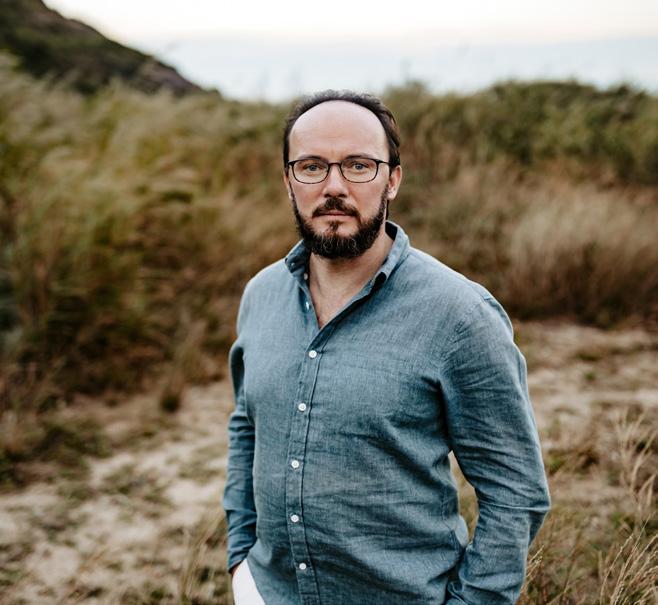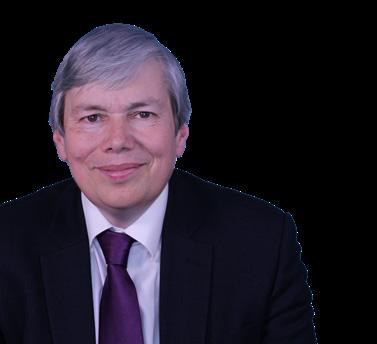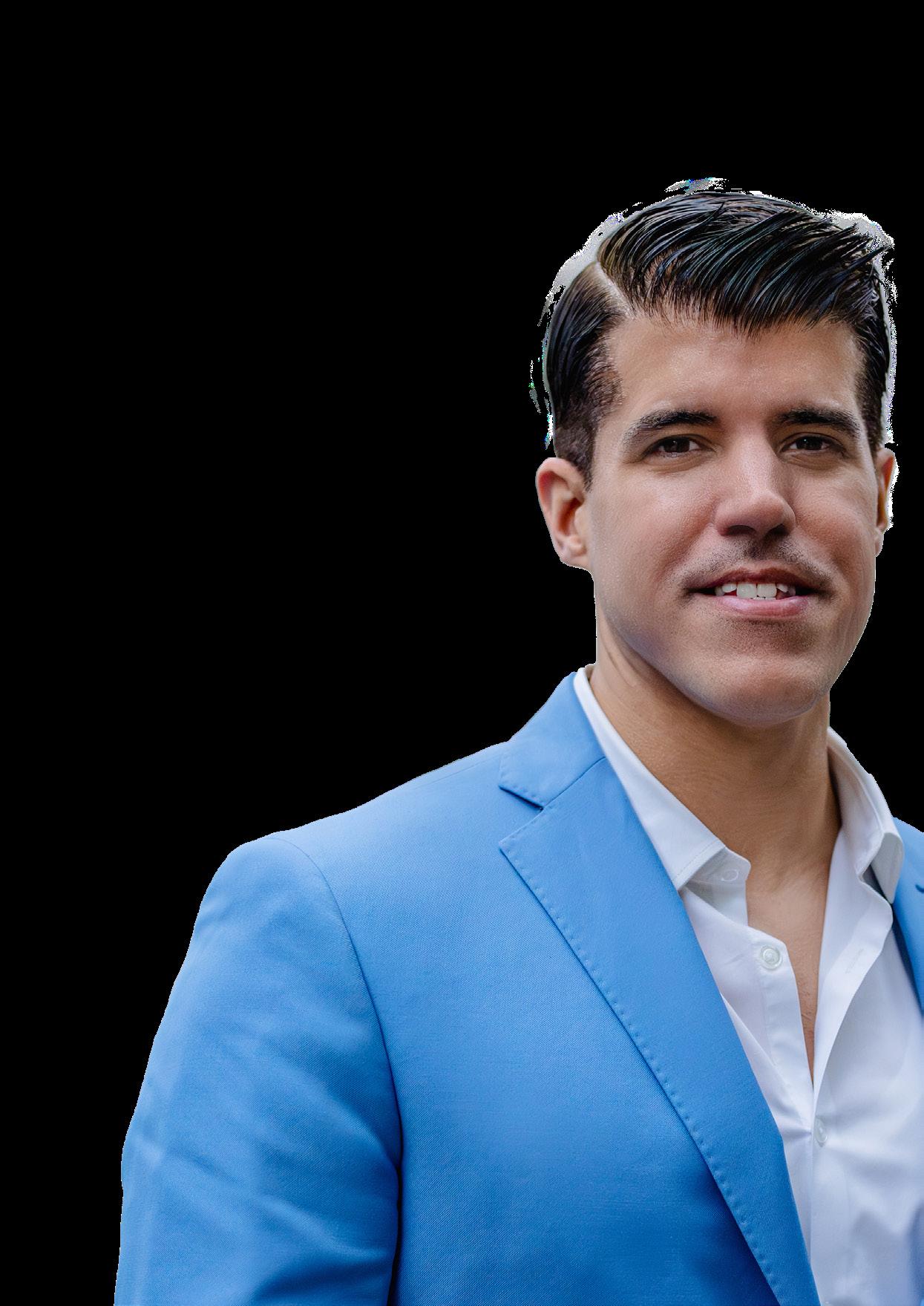
17 minute read
HOW FIDELITY BRINGS DIGITAL ASSETS TO INSTITUTIONAL CLIENTS
WRITTEN BY: ALEX CLERE
PRODUCED BY: LEWIS VAUGHAN
Advertisement
Informed by customer demand, Fidelity International has backed itself to create innovative investment products for institutional clients
When we first talk to Fidelity International, it’s one of the coldest days of the year so far in Europe, with temperatures in some parts dropping as low as -10°C. It’s representative of the mood that has swept over the crypto industry in the past year, undergoing a winter of its own. In part that has been affected by unfavourable economic conditions, price volatility, and the collapse of crypto exchange FTX and crypto lender Genesis. Retaining investor confidence in crypto, then, could be seen as an unenviable task. For Luc Froehlich, Global Head of Digital Asset Solutions at Fidelity International, it was a challenge he wanted to take on, being an early adopter of crypto.
Froehlich, who talks to me from his office in Hong Kong, started investing in bitcoin back in 2015 – the early days, so to speak, for a sector that has moved with pace in such a short period of time.
Froehlich has a background as a credit analyst, trader and a fund manager, working for industry heavyweights like
Credit Suisse and Manulife Asset Management. Cryptocurrencies were still an incredibly new frontier at that time. In 2016 and 2017, shortly after Froehlich took a step into crypto investing, a wave of initial coin offerings (ICO) started coming out.
Froehlich says, over the next couple of years, he underwent an “educational journey” –and senior leaders at Fidelity, which he joined in 2016, started becoming more vocal about the potential for cryptocurrency.
He believes that a lot has matured in the space since those halcyon days, sparked by the increasing mainstreaming of cryptocurrencies like bitcoin. In the beginning, crypto was the preserve of geeks and tech nerds – but in the last couple of years, it’s started to attract the attention of those in the traditional finance space.
“You have a space that is more professional, with quite a few people coming from a traditional finance background.
“There is definitely much more of a focus on real-world applications now – how can distributed ledger technology, in particular blockchain, be used to solve day-to-day problems? That makes it a slightly less exotic space but more interesting in the sense that it’s an opportunity to showcase how blockchain is not just a buzzword or a fad.”
Fidelity’s strong culture of innovation
The part of Fidelity’s business headed up by Froehlich focuses on digital assets and only started at the beginning of 2022, but it was the culmination of a long journey into decentralised assets. Not only was Fidelity seeking to enter the digital assets space, it was striving to future-proof its business by preparing for tokenised securities and central bank digital currencies (CBDCs) too. One way it did this was by examining the tokenisation of some of the fund share classes it offered, and identifying where there was demand in the market, Froehlich says: “If you think of digital-native investors, which are naturally more adept to digital assets, they are also looking at ways of integrating traditional assets into their portfolio or wallet. Tokenising this asset necessitates a change, an upgrade in our infrastructure, which is another area that I’m focusing on. So it’s both this convergence from client demand and need for an upgraded infrastructure that led to the decision to dedicate resources to this topic.”
The fact that Fidelity’s customers were asking them to invest in this space was one of the primary motivating factors. Froehlich believes that it would not be possible to test out this emerging area without the backing of key stakeholders within Fidelity, as well as a desire to meet customer demand.
“I think we have a philosophy of pushing the boundaries and using new technologies,” he tells us. “There is a very
Use more image captions as often as possible entrepreneurial spirit that runs within Fidelity. Most employees have an opportunity to test certain assumptions and hypotheses, to potentially launch new solutions, new services or new lines of business.”

“It doesn’t have to come from the top; there are a lot of people within the company that are given the flexibility of testing a new concept. That’s also one of the reasons that we managed to launch a standalone business dedicated to digital assets.”
Fidelity’s first digital assets product launch was not just a case of a new asset class, it was a case of a new technology that clients had to become accustomed to. Questions around custody pervaded at that time, as they do today, and there was uncertainty about the regulatory wrapper that would surround a launch of this nature.
This was in spite of the loud noise that reverberated around the crypto space. These were crucial concerns, such was the breakneck acceleration of digital assets. “Because there was so much uncertainty about the technology and a few of the environmental impacts, as well as the valuation… the question was whether it was appropriate for us to launch a product like this for our clients,” Froehlich explains. “We came to the conclusion that, because the client demand was there, our role was not necessarily to dictate what to do but to offer investors a convenient and secure way to access this asset class. So the way this product was positioned was as an access product. If you are interested and if you think that you are knowledgeable on the topic, we will provide you access. That also meant that the focus has been very much on institutional investors, and not on retail investors.”
Supporting Fidelity’s digital asset growth journey
As part of their digital asset growth, Fidelity International has been partnering with Keith Bear, Associate Partner at Elixirr and a member of the Bank of England Central Bank Digital Currency
Technology Forum and ESMA’s Consultative Working Group for financial innovation.
“Within digital assets, whilst we may be in a ‘crypto winter’ at present, institutional interest in digital assets remains high, especially with recent gains in prices of bitcoin (up 20% in recent weeks) and Ether,” Bear says. “Failures of centralised entities like FTX have prompted a ‘flight to quality’, which has benefited firms like Fidelity International. The increased focus on crypto by regulators around the world is leading to greater confidence in the asset class by institutions, and the innovation and low costs seen in DeFi protocols is prompting a wave of innovative proofs of capacity (PoCs) and pilots by leading banks, regulators and central banks, such as Projects Guardian (MAS, JP Morgan, SBI), Mariana (BIS, SNB, MAS and Bank of France) and SocGen Forge’s recent US$7m loan from the Maker Dao DeFi protocol.”
TITLE: GLOBAL HEAD OF DIGITAL ASSET SOLUTIONS
COMPANY: FIDELITY INTERNATIONAL
INDUSTRY: FINANCIAL SERVICES
LOCATION: HONG KONG SAR
Luc is the Global Head of Digital Assets at Fidelity International, where he spearheads the firm’s digital assets and cryptocurrencies strategy and engages with institutional investors.

Along with his role at Fidelity, Luc has worked with the World Economic Forum on workstreams related to distributed ledger technology, central bank digital currencies and stablecoins. He has also been advising fintech start-ups in the cryptocurrency and tokenisation space, and is a guest lecturer on digital assets at several universities.
Before joining Fidelity, Luc was a portfolio manager, managing money for central banks and pension funds; he was a trader in credit derivatives and started his career as a credit analyst.
2.57m Fidelity’s total number of customers
He holds a Master’s degree in Economics and Business Administration from the University of St. Gallen, Switzerland; is a CFA and CAIA charterholder; and is currently working towards a Master of Science in Blockchain and Digital Currency at the University of Nicosia, Cyprus.
KEITH BEAR
TITLE: ASSOCIATE PARTNER
COMPANY: ELIXIRR
INDUSTRY: MANAGEMENT
Keith is an Associate Partner at Elixirr where he focuses on Digital Asset strategy engagements. He sits on the Bank of England CBDC Technology Forum, ESMA’s Consultative Working Group for Financial Innovation, and mentors at the Techstars Barclays, ABN AMRO and Web3 Accelerators. He also serves as an Advisory Board member for a number of fintechs, as an Independent Director at DFNS, a walletas-a-service infrastructure provider, and on the Technology and Operations Resilience Committee at the London Metal Exchange. Keith is also a Research Fellow at University of Cambridge’s Centre for Alternative Finance, chairing the digital asset research programme that is supported by 15 public and private institutions including Fidelity. Previously, Keith led the Financial Markets industry at IBM.
Fidelity International and Elixirr recently collaborated in researching how many institutional clients are offering crypto and digital asset services to clients, how many have dedicated digital asset units in place, and what the perspectives are for growth of the digital assets industry.
“We are at the early stages of a transformation of financial markets,” states Bear. “Whilst the crypto market may be beginning to show green shoots in its recovery, the bigger opportunity is how the key technologies from crypto (blockchain, tokens, automated market making) will transform traditional financial markets. Tokenisation can bring great investor access to illiquid markets like private equity and real estate, broader investor access through fractionalisation of assets like art and collectibles, and great efficiencies to post-trade through the instantaneous exchange of tokenised cash and securities through atomic settlement, reducing friction and costs. Some estimates see tokenised markets being a $16tn market (10% of global GDP) by 2030, and the early innovators such as Fidelity are wellpositioned to ride this wave.”
Institutional investors adopting a long-sighted approach
The issue of knowledge and education continues to be one of crypto’s sorest points. On the retail side, research from Cardify suggests that a third of consumers who invest in crypto admit to having little or no understanding of the products they’re buying. Crypto has moved into the mainstream so

$16tn
Estimated market value by 2030 quickly that some consumers haven’t done their research properly before parting with their money – and although the picture is different with institutional investors, it points to broader challenges within the digital asset space. Extreme price volatility and the prevalence of crypto scams leave a lingering sense of unease among retail investors towards crypto –something that the past few months have only exacerbated.
“The level of understanding is still limited,” Froehlich says about retail investors. “Bitcoin was launched in 2009, so some passionate people have had time to explore the concept and make an opinion about that, but most consumers started looking at cryptocurrency around 2020 or 2021 when bitcoin was making all the headlines. In this sense, it has been a relatively short period for people to learn about digital assets. You also need to take a multi-disciplinary approach, from technology to economics, which is time-intensive and takes a while to digest.”

Like many trends within the industry, the COVID19 pandemic has proved to be a catalyst; some people spent lockdown baking bread, while others got to grips with the mechanics behind cryptocurrencies and the blockchain. But, within the retail market as a whole, there is still progress to be made.
On the institutional side, investors who have already made that decision to include digital assets within their portfolios are generally unflinching – perhaps, as Froehlich alludes to, it is because their crypto holdings represent a fairly low proportion of their overall investments and because they appreciate that, whatever happens with cryptocurrencies, traditional finance and decentralised finance are converging thanks to the adoption of distributed ledger technology.

“In addition, through the process of experimenting with digital assets, those investors have been gaining an understanding and a comfort level with this asset class,” Froehlich continues. “Interestingly, theses vary, with some investors hypothesising that bitcoin could be, for instance, the future digital gold, or Ethereum could be the next platform on which the majority of financial services are going to be built.”
Barriers to traditional adoption still persist
Despite the robust confidence in digital assets that exists among institutional investors, there are still considerable barriers to adoption. That situation has not been helped by events involving FTX and Genesis.
Froehlich states: “Even before FTX and other collapses, one of the biggest hurdles was regulation. For an institutional investor, especially if you invest on behalf of clients, you need a high degree of certainty that you are operating within an acceptable regulatory framework. That regulatory framework is not clear in most jurisdictions. There’s a lot of challenges in understanding the current statutes, and they are also continuously evolving. But this issue is normal for new technologies, and it is an opportunity for established houses like Fidelity to help share the future of this industry.”

There is also a challenge in getting institutional investors to consider what they could be doing with digital assets. That necessitates a different approach and a different way of thinking from Fidelity. He likens it to the iPhone: when that groundbreaking technology was launched over 15 years ago, people didn’t understand the full capabilities of what they could do with it, whereas now it seems second-nature to most consumers. Perhaps in 15 years’ time, the same will be said of digital assets.
“There is a bit of a change in the philosophy of how to approach investment solutions in digital assets,” Froehlich continues. “We need to be a little bit more experimental and push for innovation. This is not straightforward for traditional asset managers because it’s a different process to traditional asset classes.”
In the next couple of years, we should expect to see a rebound in the crypto market after a difficult patch – but there will also be a flurry of new applications and use-cases for digital assets, from sustainability to carbon credits and food safety. It will take time for us to identify which trends are worth capitalising on but it will be worth it because there is room for significant improvement and new business models, Froehlich says.
There will also need to be a conversation about how distributed ledger technology is implemented – whether it’s a way to provide a more convenient and cheaper access to your fund, or whether it’s the start of integrating new types of assets through tokenisation.

“I think it’s a golden era for institutional investors to move into the digital assets space because what this washout has done last year was not just to remove bad actors, but also to recognise that there were a lot of companies that just didn’t know what they were doing or didn’t have the means to cope with hyper-growth. I see the opportunity for established, highly licenced operators like Fidelity to position themselves in this market and help shape it in a way that makes it more suitable for institutional and retail investors.” fidelity.co.uk
@fidelity-international
@fidelity_uk
@FidelityUK intech is a challenging arena that innovates at an extraordinary pace, posing difficulties even for those with years of industry experience.




















The convergence of the financial world with emerging, transformative technology is rightly shrouded in language that is often difficult to decipher.
That’s one of the great things about speaking with Stephen Roche and Gabino Roche, Jr. – the twin brothers behind fintech juggernaut, Saphyre. They use metaphors and refreshingly plain language, that even a journalist can understand, to explain how forces such as AI are fundamentally changing the global financial system.
Of course, this is also important when explaining the benefits that Saphyre can offer clients and partners – and they are clearly doing a great job of that as more industry heavyweights join the ‘Saphyre Endeavour’.
“Firms have a concern about being left behind in today’s hypercompetitive financial services landscape,” explains Gabino.
“That's why it’s important that publications like FinTech share the advances that we are making with tools such as AI, and the firms that are adapting this technology, so that we can fully convey the direction that financial services are moving in.”
“There are a lot of technology vendors who pay lip service to solving the pain points that Saphyre’s proprietary platform finally solves.
Stephen and I love to tell our clients, ‘Here are the keys, you can drive the
Video Content
Fintech disruptor Saphyre makes smarter trading simple car today – not in 6 months, not in a year to get things into place’. We resolved to make Saphyre’s platform turnkey whether you are a global asset manager, a boutique bank, or a multinational custodian. When you adopt our technology, you can drive today – and you will realise the benefits. That makes the product real for an audience that tends to be skeptical of new technology.”



So, how exactly is Saphyre transforming the landscape of financial services? It’s a question that the Roche brothers tackle on a regular basis. So much so, that they have a short and a long version ready to pitch.
“What Saphyre does is instantly set up new and existing funds securely between external financial institutions, so that they can be ready to trade quickly, while eliminating post-trade issues,” says Stephen.
“Synchronising reference data in the pre-trade space eliminates much of the existing post-trade work, or redundancies, and provides critical groundwork for the move to T+1 in North America by May 2024.”
Saphyre's functionality for a client starts in the pre-trade space, before a trade even occurs, driven by intelligence rooted in more than 105 patents. For example, if a Fortune 500 company is setting up a new pension fund, the legal entity associated with that fund may need an investment management firm (many of the world’s largest are Saphyre clients). They also need to communicate with a custodian, who needs to then communicate with broker-dealers. It’s an intricate web of interfacing that is necessary for the whole machine to run.

Saphyre’s platform connects them all together to track that onboarding process: the Know Your Customer (KYC) protocols, the tax, legal, and compliance work – as well as the operational setups including things like order management systems. It’s a proprietary system that is unrivalled in an industry where most of this process was historically held together by a disparate patchwork of emails, spreadsheets, and faxes.
All of that helps firms to get ready to trade quickly and – with certain markets, currencies, trading instruments and asset classes – that speed is a very important, powerful benefit to these financial institutions.
A significant benefit to this up-front work being done in the pre-trade phase is that it takes around 70 to 75% of the work out of the post-trade, too.
“The analogy that I like to give is that you should be treating trades the same way as air travel,” says Stephen. “You set up your security precautions before any threat occurs, use a black box, add AI intelligence, some automation – and you can ensure your trades land in the destination while eliminating most of the issues in the post-trade.
“Investments are currently being done in post-trade. In other words, they are in the business of putting together crashed planes and trying to get them to fly again. We're in the business of not having planes crash – ever. “
Certain industries are known to be laggards when it comes to embracing and adopting new technologies, and you could be forgiven for thinking that finance was not one of those. However, many processes are still in the relatively dark ages when it comes to digitalisation.
Gabino and Stephen both share anecdotes of some financial organisations being stuck in a time warp. This rocky horror show includes the use of faxes (remember those?), spreadsheets, and emails. This is not representative of the entire industry of course, but it does highlight how Saphyre’s strategic relationships like FXall are using the platform to harness an entirely new approach.

Announced in February, the strategic alliance between Saphyre and the London Stock Exchange Group’s (LSEG) FXall business aims to digitise account onboarding for FXall clients through Saphyre’s AI technology.
“In the old days, you'd have to call up the banks to get the currency rates for different currencies,” says Gabino. “A platform like FXall actually draws from multiple liquidity providers to give you the best price. This is significant as it proves that Saphyre is now directly linked to trading activities, which is the breadwinning side of the business for a lot of financial institutions.”
Since that announcement, a growing number of other EMS platforms have started new formal discussions with Saphyre. Saphyre’s ability to serve multiple asset classes brings another value-add to its clients that was previously unmet.
Traditionally, many platforms are exclusively focused on certain asset classes. If a firm wants to do a certain type of trading and processing, you have to use certain solutions associated with that asset class – creating a messy network of multiple platforms within a firm’s framework.
Agility is one thing that Saphyre prides itself on, and if you want an analogy, you are not going to be disappointed.
“We move much faster than the generally accepted pace of things,” says Stephen. “We're like a speedboat doing several runs around a large cruise ship or oil tanker.”
Market forces are also, in a way, playing into the company’s hands –with turmoil in the US banking sector, ongoing geopolitical tensions, and inflation spiking globally, to name just a few pain points. In periods of uncertainty, technology and innovation have a serious role to play, and a solution like Saphyre could prove instrumental.
Saphyre has been nominated for numerous industry awards, and Gabino has emerged as a consequential fintech influencer.
They were nominated for Fintech of the Year by Global Custodian magazine and won the highly coveted award in May 2023. They have also been featured by Forbes and the Wall Street Journal, while being regular faces on the cover of FinTech Magazine and keynote speakers at FinTech LIVE.
“Saphyre quickly became the dominant player in a market that was starved of true innovation, which is very important for us,” says Stephen.
It’s not all plain sailing of course, and while Saphyre has grown exponentially in a short space of time, there are still challenges to overcome. The tactical solutions that Saphyre provides are plain to see in today’s financial environment. However, the financial industry’s historic aversion to adopting cutting- edge technology is also well known.
Right now, the firms that understand the strategic benefit are realising the first mover advantage. Although much of the investment being made by institutions today is focused on post-trade, Saphyre’s entire premise is built around the concept of solving these issues from inception, in the pre-trade first. With significant investments made in post-trade solutions, Saphyre is trying to bridge the gap – to get leaders thinking about the pre-trade.
Stephen says there is a major opportunity to show and validate post-rate solutions using pre-trade data, and that Saphyre is working

#1 Saphyre won ‘Fintech of the Year’ at the Global Custodian Leaders in Custody awards in May 2023
105 Recognised patents 2017 Year founded in US
US$18.7m Series A funding
70-75% Amount of post-trade work Saphyre can eliminate on an exciting securities lending solution right now.
“We're in the B2B space now, but this will also be repeatable to B2C. It's going to be very interesting. We are 90% there on setting that up. That will be something to look out for in the coming months, and it will be very exciting for this space, because that's a huge addressable market that hasn't been solved yet,” adds Gabino.

It all sounds like Saphyre’s stock is rising – despite economic volatility that would keep many financial executives up at night. But every crisis presents an opportunity and Gabino believes that the silver lining of today’s uncertainty could be perhaps the greatest boon for fintech firms yet.
When reflecting on what he thinks about when getting out of bed in the morning, he gets enthused by the opportunity ahead that his team sees.
“Do we have our infrastructure in place with the right players to show how we can help them navigate these conditions in the market?” he says.
“Or if we haven't, how do we get those firms to quickly adopt us so that we can help them.
The account transition issues are ongoing in the market. Can a bank remember all the account information, data, and documents and can we digitally help assist clients on both sides of the angle – the banks and depositors do this seamlessly and quickly? The answer is absolutely yes! These are the things that actually motivate us to wake up each morning.”
Stephen added, “People adopting our technology in advance of these kinds of crises will benefit from it. People who don't, will struggle, and would only then realise the change they need to make after the fact.”
“We work harder, smarter, faster to change the face of the finance industry because this is something worth striving for.” saphyre.com
@saphyra
@saphyreinc
@saphyre7792











